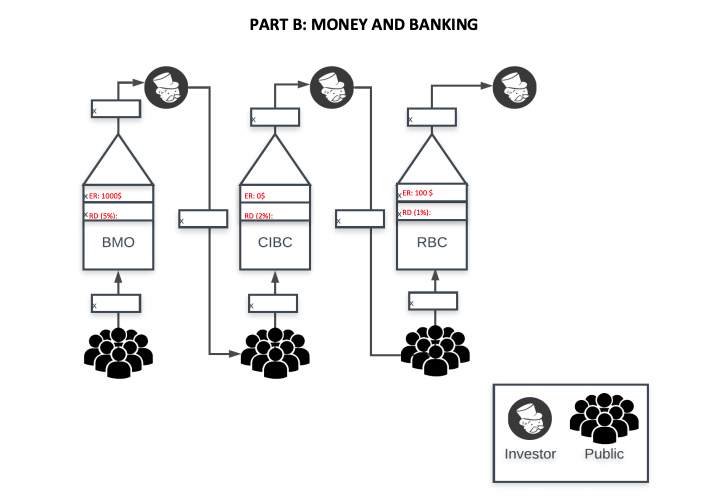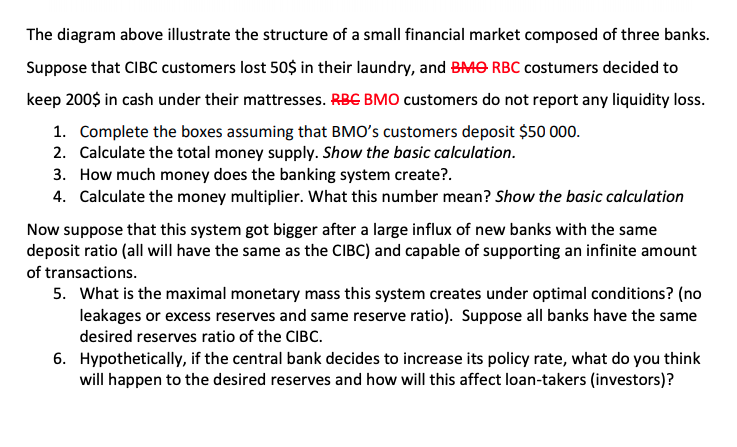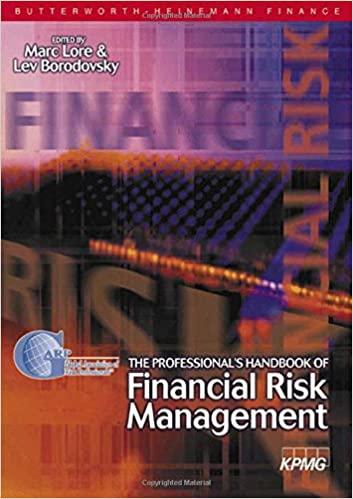Answered step by step
Verified Expert Solution
Question
1 Approved Answer
numbers 1-6 please PART B: MONEY AND BANKING ER:0$ KER: 1000$ KRD 15%): KER: 100 $ RD (1%): RD 12% BMO CIBC RBC Investor Public


numbers 1-6 please
PART B: MONEY AND BANKING ER:0$ KER: 1000$ KRD 15%): KER: 100 $ RD (1%): RD 12% BMO CIBC RBC Investor Public The diagram above illustrate the structure of a small financial market composed of three banks. Suppose that CIBC customers lost 50$ in their laundry, and BMO RBC costumers decided to keep 200$ in cash under their mattresses. RBE BMO customers do not report any liquidity loss. 1. Complete the boxes assuming that BMO's customers deposit $50 000. 2. Calculate the total money supply. Show the basic calculation. 3. How much money does the banking system create?. 4. Calculate the money multiplier. What this number mean? Show the basic calculation Now suppose that this system got bigger after a large influx of new banks with the same deposit ratio (all will have the same as the CIBC) and capable of supporting an infinite amount of transactions. 5. What is the maximal monetary mass this system creates under optimal conditions? (no leakages or excess reserves and same reserve ratio). Suppose all banks have the same desired reserves ratio of the CIBC. 6. Hypothetically, if the central bank decides to increase its policy rate, what do you think will happen to the desired reserves and how will this affect loan-takers (investors)? PART B: MONEY AND BANKING ER:0$ KER: 1000$ KRD 15%): KER: 100 $ RD (1%): RD 12% BMO CIBC RBC Investor Public The diagram above illustrate the structure of a small financial market composed of three banks. Suppose that CIBC customers lost 50$ in their laundry, and BMO RBC costumers decided to keep 200$ in cash under their mattresses. RBE BMO customers do not report any liquidity loss. 1. Complete the boxes assuming that BMO's customers deposit $50 000. 2. Calculate the total money supply. Show the basic calculation. 3. How much money does the banking system create?. 4. Calculate the money multiplier. What this number mean? Show the basic calculation Now suppose that this system got bigger after a large influx of new banks with the same deposit ratio (all will have the same as the CIBC) and capable of supporting an infinite amount of transactions. 5. What is the maximal monetary mass this system creates under optimal conditions? (no leakages or excess reserves and same reserve ratio). Suppose all banks have the same desired reserves ratio of the CIBC. 6. Hypothetically, if the central bank decides to increase its policy rate, what do you think will happen to the desired reserves and how will this affect loan-takers (investors)Step by Step Solution
There are 3 Steps involved in it
Step: 1

Get Instant Access to Expert-Tailored Solutions
See step-by-step solutions with expert insights and AI powered tools for academic success
Step: 2

Step: 3

Ace Your Homework with AI
Get the answers you need in no time with our AI-driven, step-by-step assistance
Get Started


